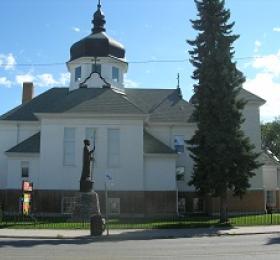Ukrainian Orthodox Cathedral of the Holy Trinity
- Regular
Description of the Historic Place
The Ukrainian Orthodox Cathedral of the Holy Trinity is a church designed in the Byzantine architectural style. Completed in 1952, the building is set on a high concrete foundation, and is located on a corner lot in the Riversdale neighbourhood. A bronze statue is located on the left hand side of the property, and is visible from 20th Street.
This historic place, located at 306 Avenue J South, is listed under Bylaw No. 6770 (Holding Bylaw). This Bylaw provides short-term protection of the building from demolition by providing for a 60 day holding period in the event a demolition permit is received. Within that 60 day period heritage designation is considered by City Council.
Heritage Value
The heritage value of the Ukrainian Orthodox Cathedral of the Holy Trinity lies in its architecture. The church was designed in the Byzantine style; a style known for its rich use of ornamental domes, colorful mosaics, and lavish decorations. The church features a brick and stucco facade with a portico with six pillars. A large single copper dome is present on the eastern portion of the hipped roof. The church was designed by Ukrainian architect C. Timoshenko with the involvement of local architect Frank Martin. The estimated cost of construction was $60,000. Sympathetic additions and changes have been made to the cathedral over the years mainly to increase user accessibility.
Inside the Ukrainian Orthodox Cathedral of the Holy Trinity is an altar located in the eastern apse, separated from the nave of the Cathedral by an iconostasis. The iconostasis is hand-carved of mahogany and Japanese oak; leaves, grape clusters and intricate scrolling surrounds a number of the holy icons. A central chandelier of Czechoslovakian crystal is suspended from the central dome. The Cathedral seats approximately 300 people.
The symbolic decoration in the traditional Orthodox style was the work of New York iconographer, Boris Makarenko. Each side of the eight-sided dome of the church depicts the major feasts of the Church and saints. Above each of the four columns at the base of the dome are icons of the Four Evangelists. A decorative border encircles the walls of the Cathedral and many of the icons are enhanced with 22-karat gold. The total cost of the iconographic work was approximately $210,000.
The heritage value of this historic place also lies in the Cathedral’s association with the religious history of Saskatoon and its importance as a neighbourhood landmark. Many of the Ukrainian settler's arriving in western Canada were of the Orthodox faith, particularly those who arrived from the eastern and central regions of Ukraine. The first Orthodox Church established in Saskatoon dates back to 1916. It was called "The Russian Orthodox Church of the Presentation of the Blessed Virgin Mary", and was originally located at 634 20th Street West.
In 1987, a bronze statue of St. Volodymyr, Baptizer of Ukraine, was placed on the grounds of the Cathedral. The statue was designed and completed by Saskatoon sculptor, Bill Epp. The Saskatoon statue is a replica of the cast iron statue of St. Volodymyr in Kiev overlooking the Dnieper River. The Saskatoon statue, cast in bronze alloy and standing on a limestone pedestal, is over seven meters high. St. Volodymyr is depicted in stately dress, with an emperor’s cape over his shoulder. His right hand grips a large bronze cross and in his left hand is his hat.
The Ukrainian Orthodox Cathedral of the Holy Trinity continues to be a prominent landmark in the Riversdale area. The building has been well maintained and offers visual value and character to the street. Through the City’s Heritage Awards Program, the church received an award for sympathetic restoration in 1998.
Source: City of Saskatoon Built Heritage Database
Character Defining Elements
Key elements which contribute to the heritage value of this historic resource include:
- Its Byzantine style of architecture, evident in: its symmetrical central-plan, single copper dome, hipped roof, and portico with pillars.
- Its brick and stucco façade;
- Those elements that reflect its use as an Ukrainian Greek Orthodox place of worship, including its Iconostasis, decorative borders, central chandelier and bronze statue; and;
- Those elements that speak to its status as a neighbourhood landmark, including its orientation on its original lot.

